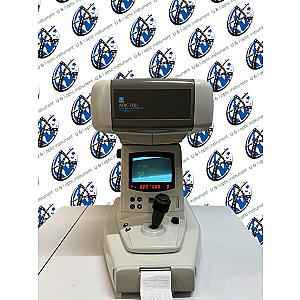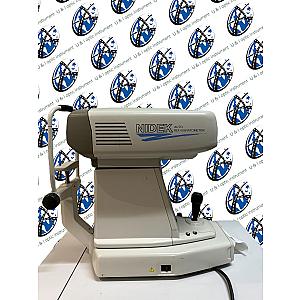The Nidek ARK-700 is an autorefractor-keratometer designed to provide precise objective measurements of both refraction and keratometry. Utilizing infrared rays and a linear CCD sensor, it delivers reliable analysis of refractive power and principal corneal curvatures. The device features a built-in microprocessor system for fast and accurate calculations. An automatic keratometry calibration mode ensures consistent and repeatable results. Compact and durable, the ARK-700 is a dependable tool tailored to meet the needs of eye care professionals.
Autorefractor-Keratometer ARK-700 - Good Condition







Description
Nidek ARK-700 Autorefractor-Keratometer: Optical Precision Serving Visual Diagnosis
The Nidek ARK-700 is a high-precision instrument engineered to meet the stringent demands of objective refraction and keratometric measurement in clinical environments. Utilizing infrared light technology, it projects slit beams onto the patient's retina and analyzes the reflected light through a photodetector sensor. This process, managed by a built-in microprocessor, enables precise calculation of refractive power—including sphere, cylinder, and axis—across multiple meridians.
Beyond refraction, the ARK-700 features an integrated keratometry module. This module projects luminous spots onto the corneal surface and measures the refracted images using linear CCD photoreceptors. The system detects the relative distances between the reflected spots with remarkable precision. The arrangement of photosensitive diodes allows for a detailed topographical analysis of the cornea along two principal meridians, with automatic calculation of the corneal cylinder axis.
A key advantage of this device lies in its auto-calibration mode for keratometry (KM auto-calibration). When reference spheres are placed in front of the eyepiece, the system performs ten successive measurements for each sphere, ensuring a margin of error below ±0.02 mm. This protocol significantly enhances result reproducibility, which is critical for longitudinal patient monitoring.
From an ergonomic perspective, the ARK-700 is operated using a joystick and a control display, providing precise alignment and easy result interpretation. The motorized movement system ensures smooth adjustments during measurements. Internal controls for brightness and contrast allow for personalized display optimization, enhancing user comfort.
Built with robust mechanics, the Nidek ARK-700 is designed to withstand intensive daily use. Its modular design permits recalibration or individual replacement of key internal components (such as the CCD sensor, measurement unit, or MIRE board), optimizing the device’s service life and making it ideally suited for ophthalmology clinics and hospital departments.
Features
- High-precision objective refraction with automatic calculation of SPH, CYL, and AXIS
- Integrated keratometry system with simultaneous analysis across two principal meridians
- Automated keratometry calibration for enhanced result reliability
- Durable construction with easily replaceable internal components
- Adjustable display sharpness and contrast for optimized visibility
- Intuitive user interface with real-time visual feedback on built-in monitor
- Suitable for both routine ophthalmic examinations and specialized follow-up
Technical Details
- Light Source: Invisible infrared rays
- Detection System: Linear CCD sensor
- Measurement Mode: Automatic refraction and keratometry
- KM Auto-Calibration: Yes, with calibration spheres of 5.95 mm, 7.94 mm, and 9.13 mm radius
- Keratometry Tolerance Range: ±0.02 mm
- Display: Built-in TV monitor
- Controls: Joystick operation with user interface
- Data Processing: Automatic calculation via embedded microprocessor
Compatible Accessories
- Calibration standard spheres (5.95 mm, 7.94 mm, 9.13 mm)
- Model eye (-10D, 0D, +10D)
- Dust cover
- External printer (depending on configuration)
- Serial communication cables